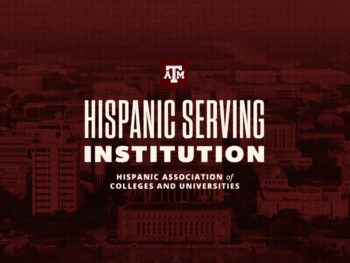Texas A&M Achieves Designation As HACU Hispanic Serving Institution

Texas A&M University has achieved designation as a Hispanic Serving Institution (HSI) from the Hispanic Association of Colleges and Universities (HACU).
HACU awards the designation to educational institutions where total Hispanic enrollment constitutes a minimum of 25 percent of the total undergraduate enrollment. Hispanic enrollment at Texas A&M reached 25 percent in fall 2020, and again in fall 2021.
Although the listing as an HSI by HACU does not certify an institution as a federally designated HSI for Title V or other federal grant purposes, Texas A&M’s Interim Vice President and Associate Provost for Diversity Annie McGowan said it’s a major step in the right direction.
“We are delighted that our progress towards achieving Texas A&M’s land-grant mission to serve students across all demographic categories is being recognized. Fulfilling our public, land-grant mission enhances our ability to deliver the marketable skills that recruiters demand,” McGowan said, noting that the employers who recruit Texas A&M students have made it clear that they seek employees with the intercultural skills necessary to meet the demands of an increasingly diverse and global economy.
“We are excited to join forces with community partners like HACU and the Texas A&M Hispanic Network (TAMHN) to realize our commitment to increasing Hispanic and Mexican American representation in our student body,” she said.
Federal designation as an HSI is determined by the U.S. Department of Education as the first step in the application process for a Title V grant. Specifically, in addition to meeting the enrollment requirement, a college or university must also meet the following criteria:
- Not less than 50 percent (35 percent with an approved waiver) of all enrolled Hispanic students must be eligible for need-based Title IV aid to qualify as an “eligible institution” by the Department of Education. Currently, approximately 22 percent of Texas A&M’s Hispanic student enrollment are considered Pell-grant eligible.
- An average educational expenditure per full-time equivalent undergraduate student that is below that of comparable institutions.
Texas A&M has been nationally recognized for its Hispanic enrollment by Hispanic Outlook on Education Magazine, which for the 2019-20 academic year, ranked the university:
- No. 12 for total bachelor’s degrees granted
- No. 23 for total master’s degrees granted
- No. 27 for total enrollment at four-year schools
- And by major:
- No. 1 for agricultural/animal/plant/veterinary science and related fields degrees
- No. 1 engineering degrees
- No. 5 natural resources and conservation degrees
- No. 6 for architecture and related services degrees
TAMHN President Monica Menzel said Hispanic students, faculty and staff bring to campus the voice of a large and growing segment of the world, and that representation matters.
“If a prospective student sees someone who looks like them, shares similar backgrounds, similar geographies, a shared language, they may feel more included and that inclusion helps assure success in their education journey at A&M,” she said, adding Hispanics are the largest growing Texas A&M alumni group.
Menzel, who earned her bachelor’s and master’s in marketing at Texas A&M in 1993 and 1994, respectively, is currently the senior vice president of Comerica Bank in Dallas. She said the HSI designation is an important threshold for the university to reach and she hopes to see even more growth in the number of Hispanic students.
“As a land-grant institution, the mission of Texas A&M is to educate the students of Texas,” she said. “Hispanics make up around 40 percent of the Texas population, but they are a younger population and schools are graduating more like 50 percent Hispanic. So we would have to double our enrollment percentage to achieve parity in our Aggie student population.”
Menzel said if Texans want the future population of the state to be prosperous and educated, this pursuit is vital in faculty and staff recruitment as well.
“Recruiting and retaining Hispanic faculty and staff make the university not just a welcoming place for new students, but also an institution where their student experiences of seeing people with similar backgrounds to them – pursuing and thriving in the higher education – help shape their expectations for themselves and for each other,” she said. “We have a saying in the Texas A&M Hispanic Network: ‘Lift as we climb.’ Culturally, the Hispanic community is an embodiment of Texas A&M’s core values – they tend to share a strong work ethic, are family-oriented and value tradition, history, respect and integrity. These are the kind of students we want as Aggies.”
Media contact: Lesley Henton, lshenton@tamu.edu





